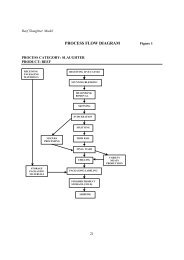Write down what went wrong and what you did about it in your diary.
Write down what went wrong and what you did about it in your diary.
Write down what went wrong and what you did about it in your diary.
Create successful ePaper yourself
Turn your PDF publications into a flip-book with our unique Google optimized e-Paper software.
Check <strong>it</strong>It is recommended that fridges <strong>and</strong> chilled displayequipment should be set at 5˚C or below.This is to make sure that chilled food is kept at 8˚Cor below. This is a legal requirement <strong>in</strong> Engl<strong>and</strong>,Wales <strong>and</strong> Northern Irel<strong>and</strong>.In Scotl<strong>and</strong>, the regulations do not set a specifictemperature for cold foods, but foods that needto be chilled should be kept <strong>in</strong> the fridge or otherchill<strong>in</strong>g equipment.You should check the temperature of <strong>you</strong>r chill<strong>in</strong>gequipment at least once a day start<strong>in</strong>g w<strong>it</strong>h <strong>you</strong>ropen<strong>in</strong>g checks (see the ‘Open<strong>in</strong>g <strong>and</strong> clos<strong>in</strong>g checks’safe method <strong>in</strong> the Management section).How do <strong>you</strong> do this?Some equipment will have a dig<strong>it</strong>al display or dial toshow <strong>what</strong> temperature <strong>it</strong> is set at. You can use thisto check the temperature of <strong>you</strong>r equipment.If <strong>you</strong> do this, <strong>you</strong> should check regularly that thetemperature shown on the display/dial is accurateus<strong>in</strong>g a fridge thermometer.How do <strong>you</strong> check the temperature of chill<strong>in</strong>gequipment?Fridge: Dig<strong>it</strong>al display/dial ThermometerChilled display un<strong>it</strong>: Dig<strong>it</strong>al display/dialThermometerIf <strong>you</strong> do not do this, <strong>what</strong> do <strong>you</strong> do?Th<strong>in</strong>k twice!Chilled food must be kept at 8˚C or below, except for certa<strong>in</strong> exceptions.When <strong>you</strong> display cold food, e.g. on a buffet, <strong>you</strong> should use su<strong>it</strong>able chilled display equipment to keep <strong>it</strong> at8˚C or below. If this is not possible, <strong>you</strong> can display food out of chilled storage for up to four hours. You canonly do this once.After this time, <strong>you</strong> should e<strong>it</strong>her put the food back <strong>in</strong> the fridge <strong>and</strong> keep <strong>it</strong> at 8˚C or below until <strong>it</strong> is used,or throw <strong>it</strong> away.If <strong>you</strong> do take food out of chilled storage to display <strong>it</strong>, remember not to mix new food w<strong>it</strong>h the food that isalready on display. This could lead to the older food be<strong>in</strong>g left out for too long.Prove <strong>it</strong>If <strong>you</strong> would like extra reassurance that <strong>you</strong>r chill<strong>in</strong>g equipment is work<strong>in</strong>g effectively, <strong>you</strong> can use a temperatureprobe to check food as a one-off test to prove that <strong>you</strong>r method keeps food at a safe temperature. (See the‘Prove <strong>it</strong>’ safe method <strong>in</strong> the Management section for advice on us<strong>in</strong>g probes safely.)What to do if th<strong>in</strong>gs go <strong>wrong</strong>• If <strong>you</strong>r fridge or display equipment breaks <strong>down</strong>,use other equipment, or move the food to acold area. If <strong>you</strong> cannot do this, or <strong>you</strong> do not knowhow long the equipment has been broken <strong>down</strong>,contact the environmental health service at <strong>you</strong>rlocal author<strong>it</strong>y for advice.• If food on display has not been kept chilled for morethan four hours, throw <strong>it</strong> away.Remember that some foods need extra care.See the safe method ‘Foods that need extra care’<strong>in</strong> the Cook<strong>in</strong>g section.How to stop this happen<strong>in</strong>g aga<strong>in</strong>• Review <strong>you</strong>r chilled display method <strong>and</strong> see if<strong>you</strong> can make <strong>it</strong> safer (us<strong>in</strong>g the front of this sheet).• Tra<strong>in</strong> staff aga<strong>in</strong> on this safe method.• Improve staff supervision.• If <strong>you</strong> have frequent problems w<strong>it</strong>h <strong>you</strong>r chill<strong>in</strong>gequipment, consider whether <strong>it</strong> is su<strong>it</strong>able for <strong>you</strong>rbus<strong>in</strong>ess. Generally, commercial equipment will bemore su<strong>it</strong>able for cater<strong>in</strong>g.Diary<strong>Wr<strong>it</strong>e</strong> <strong>down</strong> <strong>what</strong> <strong>went</strong> <strong>wrong</strong> <strong>and</strong> <strong>what</strong> <strong>you</strong> <strong>did</strong> <strong>about</strong> <strong>it</strong> <strong>in</strong> <strong>you</strong>r <strong>diary</strong>.DiaryCH2/09-06











